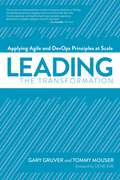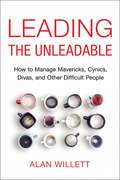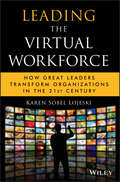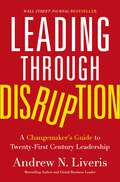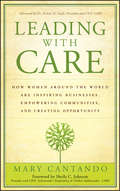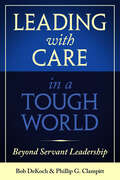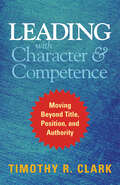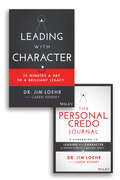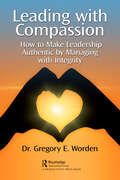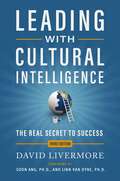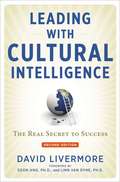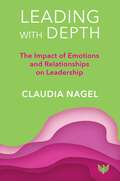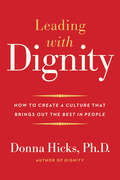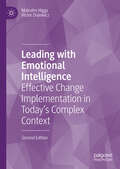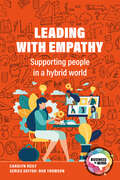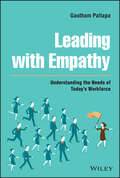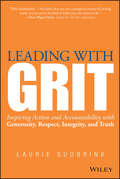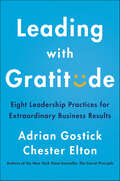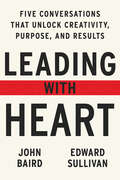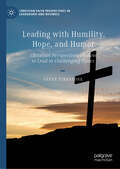- Table View
- List View
Leading the Transformation: Applying Agile and DevOps Principles at Scale
by Gary Gruver Tommy MouserSoftware is becoming more and more important across a broad range of industries, yet most technology executives struggle to deliver software improvements their businesses require.Leading-edge companies like Amazon and Google are applying DevOps and Agile principles to deliver large software projects faster than anyone thought possible. But most executives don't understand how to transform their current legacy systems and processes to scale these principles across their organizations.Leading the Transformation is executive guide, providing a clear framework for improving development and delivery. Instead of the traditional Agile and DevOps approaches that focus on improving the effectiveness of teams, this book targets the coordination of work across teams in large organizations—an improvement that executives are uniquely positioned to lead.
Leading the Unleadable: How to Manage Mavericks, Cynics, Divas, and Other Difficult People
by Alan WillettSOUNDVIEW BUSINESS BOOK OF THE YEAREvery manager has to deal with difficult employees. However, what separates the great managers is their ability to turn them into productive team players.Control freaks. Narcissists. Slackers. Cynics. Their outbursts, irrational demands, gripes, and countless other disruptions need to be dealt with, and you are the unlucky one with that job description.This book turns this seemingly difficult chore into a straight-forward process that gently, yet effectively, improves behaviors. It all begins with understanding a core truth: most people actually want to contribute results, not cause headaches. When the manager resets to that fundamental principle, the potential for change can reveal itself in even the most hopeless situations.Written by tech industry expert Alan Willett, Leading the Unleadable explains how to:Master the necessary mindsetExplain the problem calmly in a short feedback sessionGet a commitment to change, then follow upCoach others to replicate the processDevelop the situational awareness required to spot future trouble before it hitsAre you a great manager? Of course you believe you are. So don&’t just put up with your difficult employees. Anyone can do that.Turn them into the tremendous team players everyone wants them to be!
Leading the Virtual Workforce
by Lojeski Karen SobelLeading the Virtual Workforce How Great Leaders Transform Organizations in the 21st Century Praise for Leading the Virtual Workforce "Strong leadership in the best of times is difficult to achieve, but in today's rapidly changing business environment, leaders are tested in many new ways. Once again, Lojeski has a fresh take on what it takes to lead today's widely dispersed workforce. " -Ellen Pearlman, former editor-in-chief, CIO Insight magazine "Karen Lojeski has distilled the essence of the leader's role in 'managing' virtual teams. Her very relevant case stories illustrate that to be successful, the authentic leader must be able to create context and a collaborative lexicon for virtual knowledge sharing and must work diligently to build the social capital that is so vital to the success of virtual work groups. Karen's key contribution in this and her previous book, Uniting the Virtual Workforce, is the 'discovery' and clear articulation of her theory of the Virtual Distance Index, which leaders can use to measure and manage the process of virtual teamwork. " -Dave Davison, Chairman, Virtual Visuals Inc. "I agree entirely with Karen when she says that today, more than ever, effective leaders are desperately needed. She skillfully defines the dislocation and demarcation of leaders from followers through the 'Virtual Distance,' and yet paradoxically calls leaders to 'stoke the flames of innovation and cooperation in a complex, interwoven world. ' This gives rise to her exploration of the Virtual Distance Leader. As Karen points out, the twenty-first-century leader must, amidst the conditions of pressure, change, and transformation, bring human endeavor and action to value and meaning for others. " -Adrian Machon, Director, Executive & Leadership Development, GlaxoSmithKline
Leading through Disruption: A Changemaker’s Guide to Twenty-First Century Leadership
by Andrew Liveris&“Andrew Liveris takes us on a masterclass in collaborative, forward-looking leadership."- Richard Branson, Founder, The Virgin GroupIn Leading Through Disruption, Andrew Liveris provides a new leadership paradigm for resilience and agility in a rapidly changing world. This book is a must-read guide for leaders in various sectors who are keen on not only ensuring current success, but protecting the planet&’s future for everyone. Liveris, who was recently chosen to lead the Brisbane 2032 Olympic Organizing Committee and is former Chairman and CEO of The Dow Chemical Company, presents a variety of powerful tools that will enable you to tackle any problem quickly and responsively, with an eye to creating a more equitable, sustainable future. In these pages, you will learn how to:Create and use metrics that quantify the positive impact on all members of society.Collaborate with scientists, politicians, regulators, corporate boards, and other stakeholders to create effective policies that work.Broaden your company&’s focus to include both long-term sustainability and short-term profitability without sacrificing the former to gain the latter.Strengthen local communities via corporate investment and advocacy for the improvement of amenities and services for all.Hire team members who fully and proactively support strategies to improve the world and its future.Become a sought-after advisor on how to respond quickly and decisively to uncertainties. Andrew Liveris shares essential wisdom from his four decades of global leadership experience in business, government, academia, and civic society. His book is a powerful tool for any aspiring leader.
Leading with Care
by Mary CantandoIn partnership with international relief agency CARE, an inspiring look at how women around the world are developing businesses and creating opportunity.In this ground-breaking business book, management expert Mary Cantando examines the stories of women in the developing world who, with help from the non-profit organization CARE, have capitalized on personal and professional opportunities, contributed to their communities, influenced their physical environment, and overcome discrimination on the road to establishing self-sufficiency and building strong lives and strong businesses Structured around these five principles CARE's mission statement, Leading with Care expertly bridges inspiring stories of human endeavor with straight-up business lessons that all of us can apply to our work and organizations. Featuring interviews with top female executives at American companies who devote their own time and resources to CARE, we see just how much we can learn when it comes to growth, opportunity, and community. Each section ends with a discussion and specific questions that will help you integrate the lessons in your own life.In an ever-shifting world, CARE's message is timeless. Its practical approach to building businesses and self-sufficiency, in any economy, in any nation, gives us all hope and the power to create our own secure futures.
Leading with Care in a Tough World: Beyond Servant Leadership
by Phillip G. Clampitt Bob DeKoch&“A simple yet powerful promise: caring leaders can produce extraordinary outcomes.&” —Daniel H. Pink, #1 New York Times–bestselling author of The Power of Regret Breaking new ground in the exploration of servant leadership, Bob DeKoch and Phil Clampitt draw on their years of experience and research to describe, with vivid, real-world examples, how leading with care enriches people and transforms organizations in our challenging times. Gallup recently reported that only 15% of employees in the United States are truly engaged in their workplace. Yet nearly 70% say they would work harder if they felt more appreciated. Over 90% of those surveyed believed their leaders &“lacked communication skills to lead.&” The gloomy stories behind sobering statistics reveal employees&’ disappointment with current leadership approaches. Leaders can do better. That&’s why the authors sought to go beyond the laudable sentiments of the servant-leadership movement by envisioning, creating, and testing a new leadership platform based on a set of guiding beliefs and actual day-to-day practices. Their unique perspective transforms traditional practices, like employee coaching and collaboration, into dynamic self-actualizing workplaces. They also share insights about less frequently discussed leadership issues such as how to build an empowering network of relationships and transform pushback into progress. Anyone who wishes to craft their own distinctive, compelling, and empowering leadership style that unleashes the latent energy of people and their organizations will discover a robust framework for doing so in Leading with Care in a Tough World. &“Pragmatic, thought-provoking, and exceptionally well-written . . . If you&’re a leader, or aspiring to become one, I strongly recommend this book.&” —Frank Sonnenberg, award-winning author of Managing with a Conscience &“Filled with inspiring stories, practical advice and years of tried-and-true methods.&” —Dr. Marshall Goldsmith, New York Times–bestselling author of Triggers
Leading with Character and Competence: Moving Beyond Title, Position, and Authority
by Timothy R. ClarkLeading with Character and CompetenceMoving beyond Title, Position, and Authority "Leadership is an applied discipline, not a foamy concept to muse about," says three-time CEO, Oxford-trained scholar, and consultant Timothy R. Clark. "In fact, it's the most important applied discipline in the world." The success of any organization can be traced directly to leadership. And leadership can be learned. But too many books and development programs focus exclusively on skills. In reality, performance and ultimate credibility are based on a combination of character and competence. As Clark puts it, character is the core and competence the crust. He shows how greatness emerges from a powerful combination of the two, although in the end character is more important. A leader with character but no competence will be ineffective, while a leader with competence but no character is dangerous.Clark spotlights the four most important components of character and competence and offers a series of eloquent, inspiring, and actionable reflections on what's needed to build each one. Fundamentally, he sees leadership as influence—leaders influence people "to climb, stretch, and become." You need character to influence positively and competence to influence effectively. This is a book for anyone, no matter where he or she is on the organization chart. Because today employees at all levels are being asked to step up, not only can everyone be a leader, everyone has to be. Clark's insights are profound, and his passion is infectious. "Leadership" he writes, "is the most engaging, inspiring, and deeply satisfying activity known to humankind. Through leadership we have the opportunity to progress, overcome adversity, change lives, and bless the race."
Leading with Character: 10 Minutes a Day to a Brilliant Legacy Set
by James E. LoehrFrom leadership expert Dr. Jim Loehr, strengthen your moral and ethical character for outstanding leadership results with this must-have set. Leading with Character: 10 Minutes a Day to a Brilliant Legacy At the end of your life, how are you likely to be remembered? Chances are that people won’t be praising your money, power, and status. Instead, the people you’ve impacted will remember you for your compassion and personal strength—in short, your character. Unfortunately, many leaders are unaware of their character shortcomings and blind spots that hold so many of us back from building the lasting legacy we are capable of. With the right motivation, you can begin to strengthen your character and become a moral and ethical leader capable of creating lasting change. In Leading with Character: 10 Minutes a Day to a Brilliant Legacy, Dr. Jim Loehr, cofounder of the Johnson & Johnson Human Performance Institute, reveals 50 character competencies that you can practice daily to transform your life and work. This book will also guide you through the process of developing a Personal Credo that will serve as your decision-making mission statement. Most leaders never take the time to identify their own core values, instead defaulting to a reflexive form of decision making. Gain an awareness of the conscious and unconscious processes that guide what you do and why you do it, and take charge of your leadership legacy. Even good leaders are vulnerable to corruption. Read Leading with Character to learn how human evolution and contemporary culture can lead us astray without our even knowing it. As we work hard to get to the top, who are we becoming along the way? If we want to become heroes whose memories will long outlast us, we need to channel our energy into creating habits that will add up to a strong and meaningful character. The Personal Credo Journal: A Companion to Leading with Character We all want to become high impact leaders with a robust ethical and moral character, but getting there is a challenge. Dr. Jim Loehr’s Leading with Character offers a succinct plan for developing your character as a leader and building a meaningful legacy through your life’s work. The Personal Credo Journal is a day-by-day workbook that will guide you through the process of identifying your core values and crafting your Personal Credo—a statement of beliefs and values that will help you align every action and decision with your deepest held ideals. With these activities and exercises, you’ll spend just a few minutes each day reflecting on meaningful and thought-provoking prompts about your life story, your personal strengths and weaknesses, and your life goals. By the end of this life-altering, 150-day challenge, you will have gained a deep self-knowledge and a clear vision of your path forward as a leader. Take charge of the legacy you’ll leave behind, build character, and learn to use your Personal Credo to transform your life.
Leading with Compassion: How to Make Leadership Authentic by Managing with Integrity
by Gregory E. WordenBusiness schools teach the transactional tools one needs to work in business. They teach various strategic planning and decision-making models such as SPACE or SWOT or decision trees or weighted grids. They teach about the various functions of an organization, financial ratios, and breakeven analyses. And they may even have a class on business ethics. But those tools are more about knowing where the business-case boundaries are as a risk prevention measure and do not help one to think about how they should comport themselves as a leader. This book is about helping you to become your best self and helping those around you to achieve their best. Inherently it’s about authenticity, integrity, and empathy and how these simple traits can lead to high performance. The book explores ways to make our leadership more authentic and to lead with integrity. It discusses how to mentor employees and how this can lead to higher-performing teams and more successful organizations. The book is organized around four major constructs. The first is about personal leadership. It starts with honesty and integrity. That provides the basis for an empathetic leadership style. This is one that helps to engage followers and brings them along because they want to come along for the journey, rather than feeling forced. That is the nature of the second construct: building and maintaining high-performing teams. This is then the basis for building a trusting culture. Change is all around us and that can be exhausting. Building a culture of trust is the first step toward building an agile organizational culture. That is the third construct. Finally, the last is a message of simple optimism. There are many challenges facing society today, but with thoughtful, engaging leaders there is hope that we can collectively rise to the challenge.
Leading with Conviction
by Shalom Saada Saar Michael J. HargrovePractical advice and tools to help leaders at all levels elevate their skillsWhat can truly set an organization apart? There is only one asset that offers guaranteed differentiation: leadership. Leadership is a deliberate act that requires effort but yields enormous payback. According to the renowned professor Shalom Saar and co-author Michael J. Hargrove, both internationally recognized leadership development consultants, executive coaches and speakers, leadership can be learned and improved through the nine critical competencies explored in this book. Filled with sage advice and engaging examples, as well as multiple mini-assessments, this book presents a programmatic approach to engage and grow leaders at every level and in any type of organization.Outlines the nine core competencies that define exceptional leadershipUses a proven approach to enhance leadership skills that can be applied to any organizational settingOffers a wide array of practical tools for aspiring and experienced leaders Written by Shalom Saar and Michael Hargrove, the cofounders of the Center for Leadership Development, (Saar is also a leading professor at MIT and previously Harvard, as well as other top schools globally)Leading with Conviction offers a wealth of advice to help leaders establish a compelling vision, motivate their workforce, manage change and conflict, and create benchmarks that lead to sustainable success.
Leading with Cultural Intelligence
by Mai MouaLeading with Cultural Intelligence outlines the important concepts of cultural intelligence (CI) and the steps that must be practiced to become a culturally intelligent leader. CI is both a strategy and a tool that leaders can use to gain more confidence and proficiency when working across cultures. This book outlines the importance of understanding culture and its impact on organizations, the strategic value of cultural intelligence, and the significance of integrating and practicing cultural intelligence in everyday business life. When all these aspects are properly integrated and applied in the leadership and management process, organizations are more innovative and adaptable to respond to cultural changes.
Leading with Cultural Intelligence 3rd Edition: The Real Secret to Success
by David LivermoreAs our workplaces become increasingly global and diverse, being a culturally intelligent leader isn't just a bonus—it's essential.Whether you're negotiating a contract with a supplier on the other side of the world, managing an increasingly diverse workforce, expanding your business across borders, or developing and applying cultural intelligence (CQ), this classic resource provides you with the adaptability you need to motivate, negotiate, and accomplish results with anyone, anywhere.Having done consulting and research with leaders in more than 100 countries, David Livermore, founder of the Cultural Intelligence Center and professor at Boston University, has detailed the four CQ skills that are proven to maximize your leadership success in today&’s diverse, global business environment:Drive—build your motivation and confidence to address cultural dilemmasKnowledge—learn how to read any cultural situationStrategy—create an inclusive, agile plan that accounts for diverse stakeholdersAction—adapt your leadership style without compromising effectiveness Featuring the latest research, case studies, and new chapters on how to lead culturally intelligent organizations and teams, this new edition of Leading with Cultural Intelligence will help you thrive in any leadership environment—whether it's across the world or in your own back yard.
Leading with Cultural Intelligence: The Real Secret to Success
by David LivermoreBusiness today is global--and success requires a new set of skills. But not to worry, whether you're negotiating with vendors in Asia, exploring potential markets in Africa, or leading a diverse team at home, you don't have to master the nuances of every culture you encounter. With Cultural Intelligence, or CQ, you can lead effectively in any context. Featuring fresh research, case studies, and statistics on the ROI of improving your CQ, this new edition of Leading with Cultural Intelligence details a powerful, four-step model for becoming more adept at managing across cultures: Drive--boost your motivation for and confidence in interacting with other cultures Knowledge--understand the relevance of differences in religion, values, norms, and languages Strategy--plan ahead for unfamiliar cultural settings, but remain flexible if actual experience differs from expectations Action--successfully adapt your behavior to each situation With Leading with Cultural Intelligence as your guide, you'll be able to thrive in any business environment--whether it's across the world or in your own backyard.
Leading with Depth: The Impact of Emotions and Relationships on Leadership
by Claudia NagelLeadership goes well beyond efficient management, and the significance of emotions on the success of organisations is often underestimated. In Leading With Depth: The Impact of Emotions and Relationships, Claudia Nagel guides us through the emotional and relational fallacies of organisational leadership from both the personal and the systemic perspective. Nagel expertly weaves theory, including attachment, neuroscientific, psychodynamic, psychosocial, and psychoanalytic, with practical advice. She looks at the leader as an individual and leadership as a context within systems such as groups, organisations, and societies. The book is divided into two parts and contains thirty-eight figures to illustrate important aspects of leadership. The first chapter in each part is purely theoretical followed by more method-oriented and practical chapters, which are complemented by pertinent case studies from well-known experts in the field (coaches, consultants, or academics). Contributors include Gilles Amado, Birgitte Bonnerup, Phil Boxterk, Halina Brunning, Annemette Hasselager, Manfred F. R. Kets de Vries, Olya Khaleelee, Fiona Martin, Ajit Menon, Rose Mersky, Mal O'Connor, Larissa Philatova, Martin Ringer, Rob Ryan, and Kalina Stamenova. Each chapter concludes with a brief overview of the key learnings for the reader to take away. In this way, Nagel encourages practical learning and application and engagement with the text. Nagel's clear language spares the reader of academic jargon and is highly readable. The book successfully bridges the gap from theoretical concepts to real-life application and will be of value to incoming and experienced leaders alike, as well as organisational consultants and executive coaches looking to inform their practice.
Leading with Dignity: How to Create a Culture That Brings Out the Best in People
by Donna HicksWhat every leader needs to know about dignity and how to create a culture in which everyone thrives This landmark book from an expert in dignity studies explores the essential but under-recognized role of dignity as part of good leadership. Extending the reach of her award-winning book Dignity: Its Essential Role in Resolving Conflict, Donna Hicks now contributes a specific, practical guide to achieving a culture of dignity. Most people know very little about dignity, the author has found, and when leaders fail to respect the dignity of others, conflict and distrust ensue. She highlights three components of leading with dignity: what one must know in order to honor dignity and avoid violating it; what one must do to lead with dignity; and how one can create a culture of dignity in any organization, whether corporate, religious, governmental, healthcare, or beyond. Brimming with key research findings, real-life case studies, and workable recommendations, this book fills an important gap in our understanding of how best to be together in a conflict-ridden world.
Leading with Emotional Intelligence: Effective Change Implementation in Today’s Complex Context
by Malcolm Higgs Victor DulewiczDrawing on research into leadership and emotional intelligence, this updated second edition presents a framework that can lead to effective change implementation. It reflects on more recent arguments, research and changes in the areas of leadership and change, such as relational leadership, shared leadership, and the significant role of purpose beyond profit. Two new chapters explore the dark side of leadership and mindful leadership.Set against a backdrop of increasing complexity, the book responds to the need for organisations to continuously change and transform and book addresses the real challenges of effective implementation. Exploring these concepts at individual, team and organizational levels, this book recognises the complexity of the topic and combines rigour with relevance to underpin the framework with empirical evidence.
Leading with Empathy: Supporting People in a Hybrid World (Business in Mind)
by Carolyn ReilyFocusing on empathy as a key tool, this book examines the impact of hybrid working on staff mental health and how business leaders, managers, coaches and mentors can create a positive and motivated hybrid workforce.Part of the Business in Mind series, it is for anyone who is managing remote workers, whether individuals or teams. As the world of work has changed drastically since the Covid-19 pandemic with more staff working from home, the importance of nurturing staff well-being is more important than ever. Even though businesses are seeing the benefits of working at home, it can also create challenges. With the latest research and studies, this book explores practical ideas for finding the right working model and how to develop an appropriate leadership style. Uniquely, it discusses the neuroscience of stress to identify ways to improve workers' mental health and inform how managers can use this to create a positive work environment.
Leading with Empathy: Understanding the Needs of Today's Workforce
by Gautham PallapaLearn to lead others through adversity with the power of human connection. In Leading with Empathy: Understanding the Needs of Today’s Workforce, acclaimed strategist and business leader Dr. Gautham Pallapa presents an insightful roadmap to leading people through adversity and empowering humans in the workplace, the home, and society. Through this book, the distinguished author examines the impact of recent world-shaking events and how they have impacted us as a species and as individuals. He explores how empathy can help alleviate some of the more harmful effects of hardship and offers key actions that empathic leaders can take to inspire their followers. Finally, the book describes how to transform the way we work by rethinking and reimagining existing processes and innovatively introducing strategic disruption. Leading with Empathy also includes: Stories, anecdotes, and personal musings that grant visibility and validation to the suffering of others Exercises and strategies to reduce stress, anxiety, and improve happiness and positivity Actions that enable leaders to empower people through empathy, collaboration, and communication. An essential read for executives, managers, and business leaders of all types, Leading with Empathy will also earn a place on the bookshelves of military, athletic, and educational leaders who seek to inspire their followers and empower humanity in the face of adversity.
Leading with Feminist Care Ethics in Higher Education: Experiences, Practices, and Possibilities
by Christie SchultzThis book explores how academic leaders throughout higher education experience and practice care and the ethics of care. Drawing on a narrative inquiry study of experiences and practices of feminist care ethics in higher education leadership, Schultz counters academic norms, including expectations of competition and criticism across all activities, by uncovering the common experiences of academic leaders who intentionally adopt practices guided by an ethics of care and relationality. Within the context of institutions of higher education responding to present-day social movements, the book highlights how practices of care-centered leadership can enable change that begins on campus and reaches outwards to positively impact the community.
Leading with GRIT
by Laurie SudbrinkImprove yourself - and your workplace - with GRIT Leading With GRIT is a practical and proven guide for transforming the workplace, offering pragmatic insight on value-based strategies that improve the individual and the business. Based on the author's proprietary principles of GRIT - Generosity, Respect, Integrity, and Truth - this book describes how working toward individual improvement produces better organizational results than traditional approaches that focus on collective improvement. Readers are introduced to GRIT with a framework that can be applied in any workplace scenario, and are provided with strategies for applying GRIT to communication and intra-office operations. Each chapter includes activities that assist with implementation, moving beyond the theoretical framework commonly taught in business school to provide a more practical approach to personal development. The principles of GRIT are exactly the sort of instruction leaders are encouraging, and companies worldwide are willing to invest large sums. The approach stands out for its unique, personal approach that melds values-based principles with business concepts to produce spectacular results. This book is the complete guide to GRIT, with an emphasis on practicality. Learn why the principles of GRIT have proven so effective Apply GRIT in communications for better productivity Discover how each person impacts those around them Cultivate a positive, constructive attitude for less stress and more growth GRIT helps readers make themselves and their workplaces happier and healthier, decreasing stress, sparking personal growth, retaining employees, and developing mindful leaders. In essence, Leading With GRIT is a handbook for improving the bottom line by improving the lives and outlook of those who contribute to it.
Leading with Gratitude: Eight Leadership Practices for Extraordinary Business Results
by Adrian Gostick Chester EltonThe influential New York Times bestselling authors—the “apostles of appreciation” Chester Elton and Adrian Gostick—provide managers and executives with easy ways to add more gratitude to the everyday work environment to help bolster moral, efficiency, and profitability.Workers want and need to know their work is appreciated. Showing gratitude to employees is the easiest, fastest, most inexpensive way to boost performance. New research shows that gratitude boosts employee engagement, reduces turnover, and leads team members to express more gratitude to one another—strengthening team bonds. Studies have also shown that gratitude is beneficial for those expressing it and is one of the most powerful variables in predicting a person’s overall well-being—above money, health, and optimism. The WD-40 Company knows this firsthand. When the leadership gave thousands of managers training in expressing gratitude to their employees, the company saw record increases in revenue.Despite these benefits, few executives effectively utilize this simple tool. In fact, new research reveals “people are less likely to express gratitude at work than anyplace else.” What accounts for the staggering chasm between awareness of gratitude’s benefits and the failure of so many leaders to do it—or do it well? Adrian Gostick and Chester Elton call this the gratitude gap. In this invaluable guide, they identify the widespread and pernicious myths about managing others that cause leaders to withhold thanks.Gostick and Elton also introduce eight simple ways managers can show employees they are valued. They supplement their insights and advice with stories of how many of today’s most successful leaders—such as Alan Mulally of Ford and Hubert Joly of Best Buy—successfully incorporated gratitude into their leadership styles.Showing gratitude isn’t just about being nice, it’s about being smart—really smart—and it’s a skill that everyone can easily learn.
Leading with Heart: 5 Conversations That Unlock Creativity, Purpose, and Results
by John Baird Edward SullivanTwo veteran executive coaches help today's leaders learn how to retain and inspire their teams through the one thing their research has found works: Leading with Heart. In these pages, leadership coaches John Baird and Edward Sullivan share hundreds of hours of research and firsthand accounts of guiding leaders at some of the world's most respected big brands and small startups (Apple, Nike, Google, and Slack to name a few). Through their coaching and research they uncovered the five behaviors transformative leaders engage in to connect authentically with their teams: They are aware of their people's needs. They help their people to confront the fears that hold them back.They understand their own desires and what drives their people. They leverage their unique gifts and help people find their own. They connect with their core sense of purpose and help people find theirs. The key to achieving these behaviors is asking the right questions and having conversations that connect you and your employees on the deepest human level—conversations the authors coach you on how to navigate.At a time when workplaces are struggling to build high morale and connected cultures, Leading with Heart will help leaders to unlock the best version of themselves and those around them with transformative results.No matter where you are in your career, this book is your launch point to leading with heart. By encouraging you to ignore outdated “leadership hacks” and embrace introspection and growth, Leading with Heart guides you to ask the right questions and find your own answers. Now you too can create a leadership game-plan that is authentic to you and brings out the best in those around you.
Leading with Humility
by Rob Nielsen Jennifer A. Marrone Holly S. FerraroThe media is saturated with images of leaders as powerful, headstrong individuals, who are certain of their position and willing to do whatever it takes to achieve their organizational goals or personal ambitions. In reality, far too often, a leader’s ego gets in the way of sound decision making, adversely affecting the organization and the individuals involved. This insightful book, based on cutting edge research, advances a new model for understanding effective leadership. Nielsen, Marrone and Ferraro advocate the idea of leading with humility, a trait that is rarely discussed and frequently misunderstood. Humble leaders consider their own strengths, weaknesses and motives in making decisions, demonstrating concern for the common good, and exercising their influence for the benefit of all. Leading with Humility offers students and leaders clarity in understanding the connection between leadership and humility, and teaches them how to enhance their own abilities to become better leaders.
Leading with Humility, Hope, and Humor: Christian Perspectives on How to Lead in Challenging Times (Christian Faith Perspectives in Leadership and Business)
by Steve FirestoneThis book explores the intricate interplay between humility, humor, and hope in the context of Christian leadership. Drawing upon biblical foundations and contemporary leadership theories, it provides a comprehensive understanding of how these three qualities synergize to enhance the effectiveness of Christian leaders. By examining their individual significance and exploring their combined impact, this volume advances the field of organizational leadership, particularly in addressing the challenges of leadership in a manner consistent with Christian principles. The authors illuminate the crucial roles of humility, hope, and humor in Christian leadership, making this a valuable resource for researchers interested in leadership within the context of faith. This contribution will aligns with existing literature on how Christians can leverage their faith for improved leadership capabilities.
